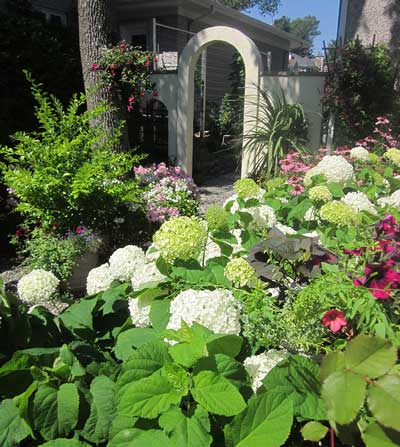From the Magazine: January 2015

Whether freestanding or attached to the walls of the garden or home, an arch creates a special invitation to enter or explore.
by Diane Morey Sitton
Garden Arches
The gold standard in outdoor focal points
Arches have long been the mark of passageways, but in gardens the classic form serves multiple functions. When paired with gates at garden entrances, arches say “Welcome.” When used as transitions between garden rooms, arches create a sense of journey, beckoning visitors with the promise of things to come.
Ever stretching skyward, they provide instant height. They support plants in a quest for sunshine. Arches are useful, too, when positioned to frame statues, water features or distant views.
The right stuff
Whether installed at a strategic spot in the garden or constructed as part of a permanent wall or fence, an arch’s size, style, material and strength should be in keeping with its surroundings and purpose.
Sizing them up
Like all garden elements, arches are most pleasing when they are in scale with the landscape. If it is to be used at an entrance or to span a garden path, select an arch that is wide enough to accommodate traffic, especially if the structure will be used as a framework for climbing plants.
Style setters
As focal points, arches play a major role in setting garden style. Use their towering presence to reinforce design, whether in cottage gardens, rose gardens, contemporary landscapes, or formal settings. Although all arches share the same classic shape, they are available in various styles. Traditional French-style arches are characterized by flat profiles. They pair well with climbing roses. With their swirls, finials and other embellishments, Gothic motifs enhance English garden design. Large Roman-look arches are best for spacious settings. Create a faux pergola by installing three or more in a row.
Materials matter
Although durability and budget can influence material selection, the material the arch is constructed from should complement other hardscape elements, garden style and home design. Despite being a budget-stretcher, wrought iron is durable and exudes classic beauty. Copper offers unmatched patina, melding into the garden with age. An eco-friendly choice, wood arches are available in simple and complex styles.
Permanently built arches are constructed from brick, adobe, stucco or other materials. These structures can be freestanding, designed as part of a fence, or fashioned into a wall extending from a house.
Tough enough
Before building or adding an arch, determine its purpose. Arches that support climbing plants carry the burden of the plants’ weight at maturity, so they must be strong. Stability, too, is important. Arches sustain wind, rain, and other weather events. Reinforce them, if necessary. Usually, homeowners hire experienced professionals to construct permanent arch structures.
Whether you designate them as decorative focal points or put them to work supporting vines or climbing roses, arches are champions of form and function. What more could you ask for in a finishing touch?
